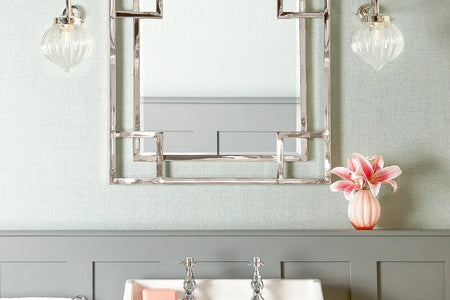
Here are nine expert tips for using lights to make even the smallest rooms seem large and airy…
There are lots of well-known interior design tricks for making a small room look bigger – from storage cunningly built into furniture to huge mirrors on the walls or optical illusions like stripy rugs on the floor. But have you thought about the importance of lighting in helping to create a sense of space?
1) Spread the light around
First and foremost, don’t rely on a single light source in the centre of the room. One ceiling lamp will only cast a pool of light on the middle of the floor. Instead, use multiple light sources around the room to open it up, such as floor lamps in corners and table lamps on sideboards.
This will spread focus across the full area of the room (and will also give you more control over different moods in the room – see our guide to layering light in the home.)
2) Use lights to enhance corners and recesses
On the theme of spreading light around, try using wall lights in awkward recesses or corners. For example, lighting the spaces on either side of a chimney breast will make the room seem wider. And if wiring and plug sockets are an issue, no problem! Try a rechargeable table lamp or wall light: perfect for reaching difficult, out-of-the-way spots.

Twinky rechargeable wall lights - no need for wiring!
3) Use long pendants to emphasise the height of a room
One of the most common tricks for making a room seem bigger is to utilise vertical space. If you lack square footage but have a reasonably high ceiling, you can focus attention on this with tall, thin furniture and high shelves – and for your lighting try a long pendant hanging from the ceiling. It will draw the eye up and down, emphasizing the room’s height rather than its small floor space.
Smallest Zindarella pendant light in clear glass. Long pendants emphasis the vertical space in a room with a small square footage
4) Make a statement with a big flamboyant lamp
There are two (apparently opposite) schools of thought concerning objects and ornaments in a small space: either restrict yourself to proportionately small items, or just have one or two big ones. So you could try having a single big statement lamp with a flamboyant shade in an otherwise emptyish room...5) Use tall, spindly lamps with small shades
…or if that’s not your cup of tea, go for tall, spindly table lamps with small shades. The general rule of thumb for getting the right size lampshade is that the height of the shade should be about three-quarters the height of the base, and that if in doubt you should go for a bigger shade. However, rules are made to be broken, and very thin and tall lamps can often suit smaller shades. This will give you more space and help to emphasise the verticals in the room. (See our complete guide to choosing the right lampshade here.)
The larger Trafalgar table lamp in antique brass - a tall slim base, with a small shade
6) Pick the right colour lampshades
Most colour schemes designed to give a room more space and air are based on light colours: white walls and drapes, light wooden floors and pale furnishings. So in many cases you’ll probably want to go for matching light, neutral lampshades for your floor and table lamps, perhaps made of linen or silk. (However, this is another rule that can be broken in the right circumstances. A dark, opaque shade is ideal if you want to send light upwards to accent a feature or a corner, rather than use lamps for general ambient light.)7) Bounce light off a mirror
Mirrors are the oldest trick in the book when it comes to creating the illusion of space. The classic method is to place a large mirror opposite a window, but if you can’t (or don’t want to) rely on natural light, place mirrors opposite your wall lights for a similar effect. (Incidentally, one of the best mirror tricks is to place a floor-to-ceiling one behind a piece of furniture like a side table or cabinet. This will create an illusion of a whole other room opening up behind it.)
Pooky's larger Portal mirror in blue spruce
8) Use square shades to fit lamps onto small surfaces
If you want to place a table lamp on a very narrow table, a mantelpiece or an awkward little shelf, try using a square lampshade. This means you can push it right up against the wall, saving valuable space.
9) Dazzle with glass
This is another classic space-making interior design trick: use see-through furniture such as glass tables to remove barriers for the eye and open up a room.
But you can also use glass in your lighting for similar effects. The Wisteria table lamp (below) makes ingenious use of a glass cylinder, while a glass wall light is a great way to maximise the light around a room, both when lit at night and during the day.

Wisteria rechargeable table lamp in glass finished in antique brass
At Pooky we’re not just about beautiful lamps – we love the way that you can use light to make beautiful interiors. Read many more tips and inspirational ideas on our interiors blog.
See also:
Interior design for small homes: 7 expert tips
Colour theories in interior design and lighting: neutrals
How to light an open plan space - 5 top lighting tips
How to boost the natural light in your home
Home lighting design: a guide to layering light
Image top: kitchen by Toby Perryman-Payne. Photo: @tobyshome













